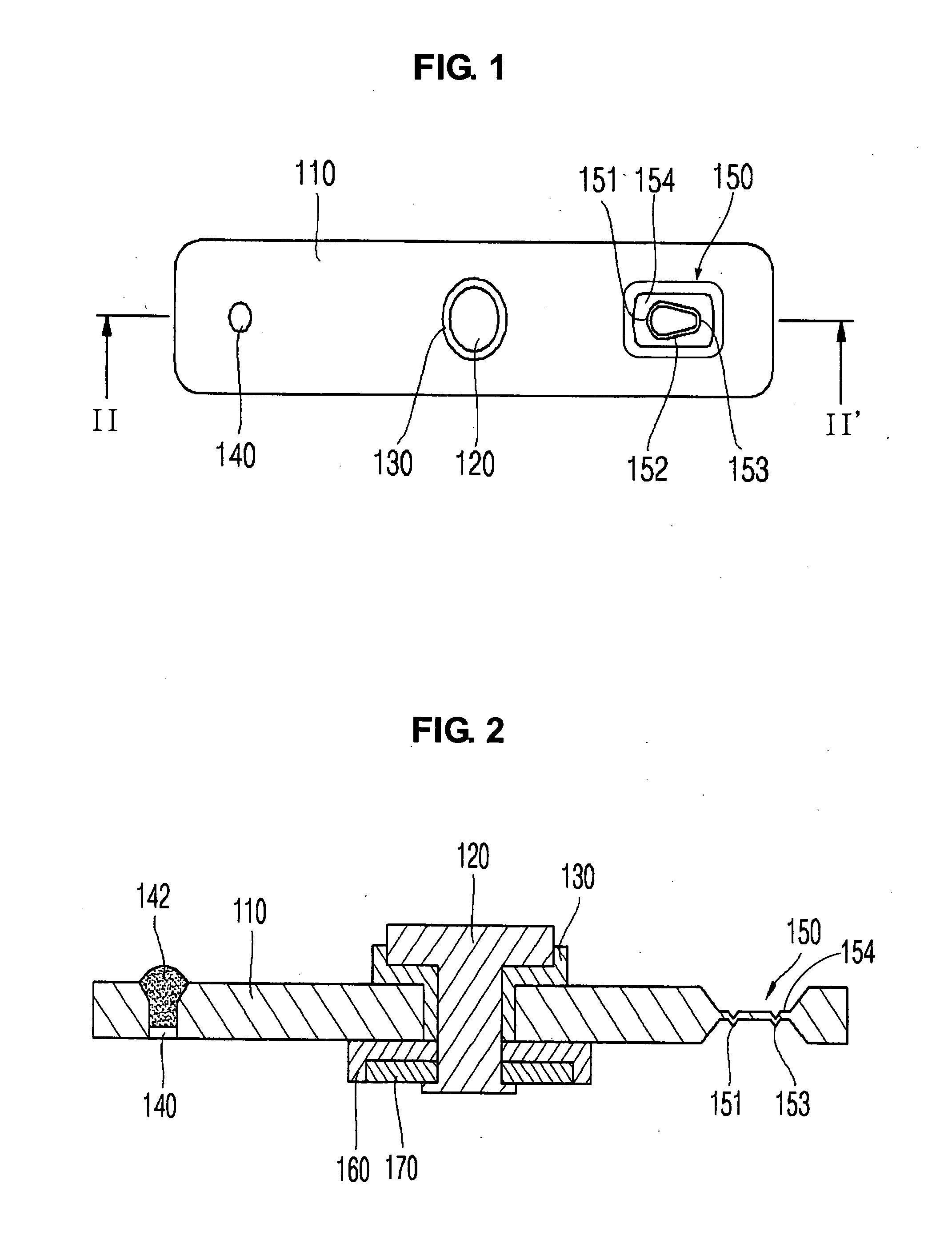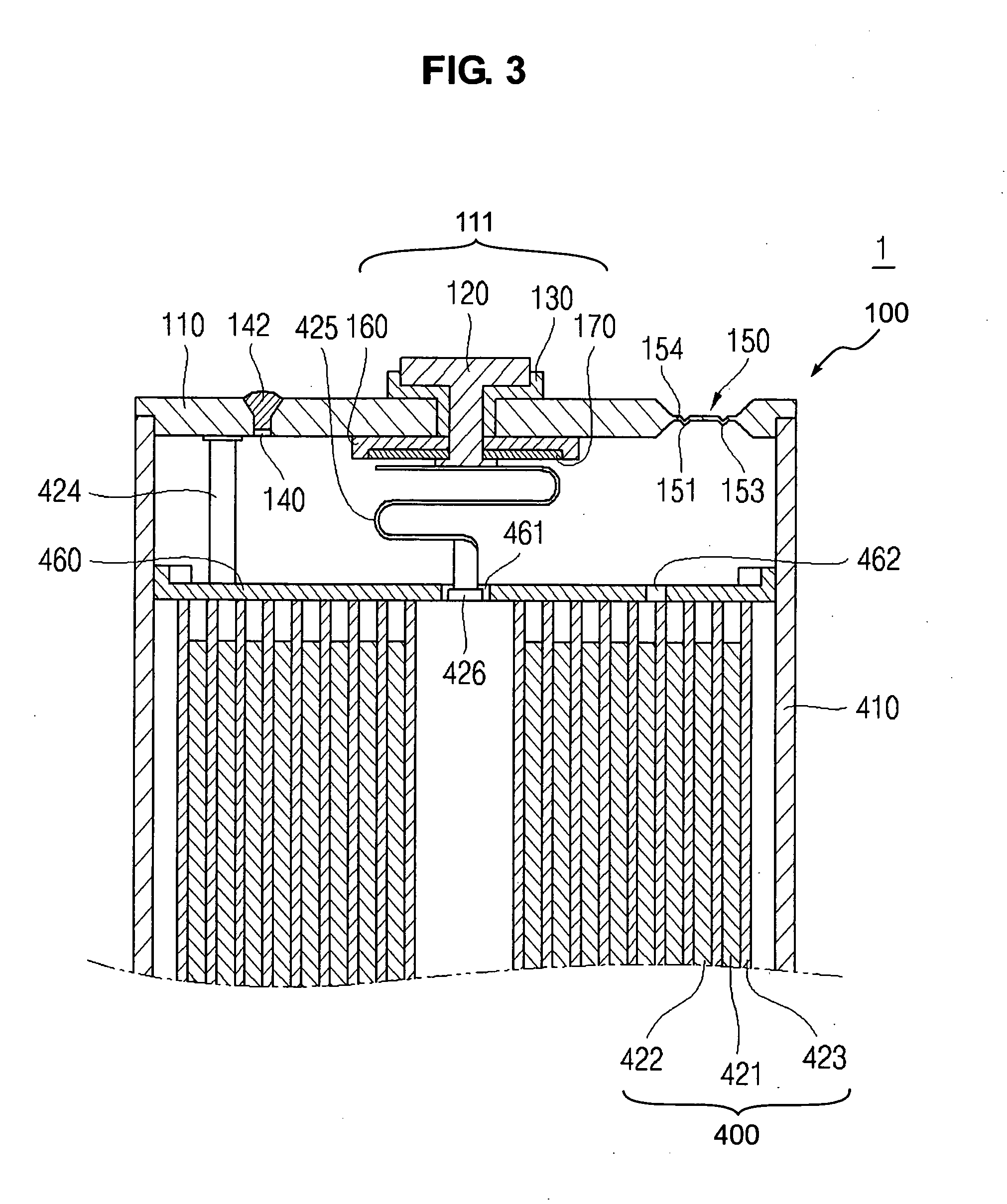Secondary battery
a battery and secondary technology, applied in the field of secondary batteries, can solve the problems of short circuit, non-uniform current or potential, battery deterioration, etc., and achieve the effects of reducing the internal pressure of the battery, and reducing the defect of burs
- Summary
- Abstract
- Description
- Claims
- Application Information
AI Technical Summary
Benefits of technology
Problems solved by technology
Method used
Image
Examples
experimental example 1
[0053]An asymmetric-track-shape safety vent having a thickness of 24 μm and a rupture pressure of 22±3 kgf / cm2 is formed in the cap plate. The length of the safety vent in the lateral direction of the cap plate is in the range of 4.8 mm to 5.2 mm, and the length of the safety vent in the longitudinal direction of the cap plate is in the range of 2.8 mm to 3.2 mm. The lateral direction corresponds to the long side of the cap plate and the longitudinal direction corresponds to the small side of the cap plate. Then, a hot plate test is performed at a temperature of 250° on five bare cells having these asymmetric safety vents and secondary batteries having symmetric safety vents according to the related art. As a result, all the secondary batteries having the symmetric safety vents according to the related art reach Step L5 (burst), while all the asymmetric-track-type safety vents of the five bare cells according to the invention are normally operated and do not reach Step L5 (burst). A...
experimental example 2
[0054]An asymmetric-track-shape safety vent having a thickness of 27 μm and a rupture pressure of 22±3 kgf / cm2 is formed in the cap plate. The length of the safety vent in the lateral direction of the cap plate is in the range of 4.8 mm to 5.2 mm, and the length of the safety vent in the longitudinal direction of the cap plate is in the range of 2.8 mm to 3.2 mm. The length of the safety vent in the longitudinal direction of the cap plate refers to the maximum length of the safety vent in the longitudinal direction of the cap plate and refers to the maximum length of the safety vent in the direction perpendicular to the lateral direction. Then, a hot plate test is performed at a temperature of 2500 on ten bare cells having these safety vents and secondary batteries having symmetric safety vents according to the related art. As a result, similar to the experimental example 1, all the secondary batteries having the symmetric safety vents according to the related art reach Step L5 (bur...
experimental example 3
[0055]An asymmetric-track-shape safety vent having a thickness of 30 μm and a rupture pressure of 22±3 kgf / cm2 is formed in the cap plate. The length of the safety vent in the lateral direction of the cap plate is in the range of 4.8 mm to 5.2 mm, and the length of the safety vent in the longitudinal direction of the cap plate is in the range of 2.8 mm to 3.2 mm. The length of the safety vent in the longitudinal direction of the cap plate refers to the maximum length of the safety vent in the longitudinal direction of the cap plate and refers to the maximum length of the safety vent in the direction perpendicular to the lateral direction. Then, a hot plate test is performed at a temperature of 250° on five bare cells having these safety vents and secondary batteries having symmetric safety vents according to the related art. As a result, similar to the experimental examples 1 and 2, all the secondary batteries having the symmetric safety vents according to the related art reach Step...
PUM
| Property | Measurement | Unit |
|---|---|---|
| thickness | aaaaa | aaaaa |
| rupture pressure | aaaaa | aaaaa |
| length | aaaaa | aaaaa |
Abstract
Description
Claims
Application Information
 Login to View More
Login to View More - R&D
- Intellectual Property
- Life Sciences
- Materials
- Tech Scout
- Unparalleled Data Quality
- Higher Quality Content
- 60% Fewer Hallucinations
Browse by: Latest US Patents, China's latest patents, Technical Efficacy Thesaurus, Application Domain, Technology Topic, Popular Technical Reports.
© 2025 PatSnap. All rights reserved.Legal|Privacy policy|Modern Slavery Act Transparency Statement|Sitemap|About US| Contact US: help@patsnap.com



